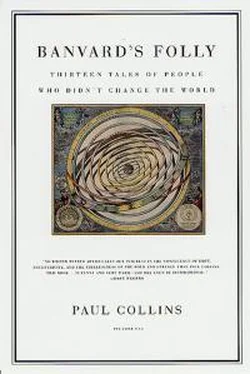legend; A legend an Arab related to me. We sat by a fountain beneath a high
mountain, A mountain that soar'd by the Syrian sea: When a harvest moon shewed its silvery sheen, Which called into thought the Arabian's theme.
The book's epilogue descends into a miscellany of details about English church building, Egyptian obelisks, and loony speculations about Masonic oaths, a subject of apparently inexhaustible interest to the author.
On a more practical note, Banvard also authored a pocket-size treatise titled Banvard's System of Short-Hand (1886)--one of the first books published in the Dakota Territories. He claimed the system could be learned within a week, and that he had been using it for years, keeping in practice by surreptitiously transcribing conversations on buses and ferryboats: "The author acquired the knowledge of shorthand precisely in this manner when he was but a youth ....
He has many of these little volumes now in his possession and they have become quite of value as forming a daily journal of these times."
For transcription practice, Banvard included his own poems and pithy maxims, such as "He jests at scars who never felt a wound." Banvard had felt some wounds himself of late, and more were to come before his strange journey came to an end. But that same year, now into his seventies, he locked himself in his studio one last time, ready to produce a final masterpiece.
Dioramas and panoramas were no longer a novelty by 1886, and Edison's miraculous work in motion pictures was just over the horizon. If the art form hadn't aged well, neither had its greatest proponent--along with the usual infirmities of age and his ruined finances, Banvard's eyesight had worsened with age. His eyes had never been terribly strong since his childhood laboratory mishap. Still, even now he could muster a certain heartiness. "In his mature years his appearance was like that of many Mississippi River pilots," said one contemporary. "A thickset figure, with heavy features, bushy dark hair, and rounded beard."
Nonetheless, Banvard's family was uneasy with his notions of taking the show on the road one last time, as his daughter later recalled: "My mother and the older members of the family were quite averse to his giving it [the performance], as they felt his health was too impaired for him to attempt it."
If the older members of the family were against it, one can imagine the solace Banvard took in his grandchildren, who were only now seeing the family patriarch revive the art that had made him rich and famous long before they were even born.
For his diorama, Banvard had chosen a cataclysm still in the living memory of many Americans: "The Burning of Columbia." Most of the capital city of South Carolina was burned to the ground by General Sherman's troops in a day-long conflagration on February 17, 1865. Banvard's rendition of it was by all accounts a magnificent performance. Even more impressively--in an echo of his humble beginnings--Banvard ran the diorama and a massed array of special effects as a one-man show. One audience member recalled: Painted canvasses, ropes, windlasses, kerosene drums, lycopodium, screens, shutters, and revolving drums were his accessories. Marching battalions, dashing cavalry, roaring cannon, blazing buildings, the rattle of musketry, and the din of battle were the products, resulting in a final spectacle beyond belief, when one considers it was a one man show.
I have read of the millions expended in the production of a single modern movie, but when I remember what John Banvard did and accomplished in a spectacular illusion in Watertown, Dakota Territory, more than fifty years ago for an outlay of ten dollars, I am rather ashamed of Hollywood.
For all the spectacle, though, Banvard's day had long passed. Dakota was simply too sparsely populated to support much of a traveling show, and the artist found himself packing away the scrims, drums, and screens for one last time, never to be used again.
A few years later, in 1889, his wife, Elizabeth, died. They had been married for more than forty years. As is so often the case in a long companionship, the spouse followed not long afterward. A visitor to Banvard's Watertown grave will scarcely guess from the simple inscription that this was once the world's richest artist:
JOHN BANVARD
Born Nov. 15, 1815
Died May 16, 1891
As word of his death reached newspapers back East and in Europe, editors and columnists expressed amazement. How could this millionaire have died penniless on a lonely frontier? Had they sought to get any answers from his family, though, they would have come up empty-handed. Unable to pay their bills, the Banvards all fled town after the funeral.
In their haste to evacuate their house on 513 Northwest 2nd Street, they had left much behind, and an auction was held by creditors. Among John Banvard's remaining possessions was a yellowed scrap of paper listing his unpd $15.51
bill for his own father's funeral service in 1831. Young John had spent his life haunted by his father's lonely death and humiliating bankruptcy. Sixty years later, still clutching the shameful funeral bill, he had met the same fate.
So where are his paintings?
His early panoramas of the Inferno, Venice, and Jerusalem were lost in a steamboat wreck in the 1840's. A few small panels are scattered across South Dakota; the Robinson Museum, in Pierre, has three. Two more are in Watertown: the Kampeska Heritage Museum has "River Scene with Glenada," while the Mellette Memorial Association has a hint of the "Three Mile Painting" with
"Riverboats in Fog."
And what of the paintings that made his fame and fortune, the ingenious moving panoramas? One grandson, interviewed many years later, remembered playing on the massive rolls when he was little. But after Banvard's death, they lay abandoned to the auctioneer. Edith Banvard recalled in a 1948 interview: "I understood that part of it was used for scenery ... in the Watertown opera house." From there, she conjectured, the rolls may have been cut into pieces and sold as theater backdrops. Worn from decades of touring, and torn from their original context as moving pictures, they might have seemed little more than old rags. Not surprisingly, no record is known of what theaters might have done with them.
One persistent account, however, holds that Banvard's masterpieces never left Watertown at all. They were shredded to insulate local houses--and there, imprisoned in the walls, they remain to this day.
THE CLEVER DULLARD
William Henry Ireland was a dullard. That, at least, is what everyone always told him. Born of dubious parentage in 1775 to London engraver and antiquarian Samuel Ireland, William was a muddle-headed boy who was unable to apply
himself at much of anything. He was sent home from one school holding a note to his father explaining that William was simply too stupid to be taught, and that to collect any further tuition fees "was little better than robbing Mr.
Ireland of his money."
William spent so little energy on the outside world because his inner world was simply more interesting. Freed from any expectations of greatness from his family or his teachers, young William Ireland would haunt the streets of London, hanging about the stage doors of theaters to observe the actors coming and going, and then going home and painstakingly building little theaters of cardboard in his bedroom.
Later he became fascinated by medieval heraldry. Old helmets and breastplates, dinged and rusty and useless in an era of gunpowder, collected dust in odd corner stalls around London, and so William happily poked around looking for odd bits from broken-up suits of armor. Once home with his newfound treasures, William scrubbed the rust off and polished them, and then sat in his bedroom trying to assemble his jumbled collection of odd pieces into a suit of armor.
Читать дальше











